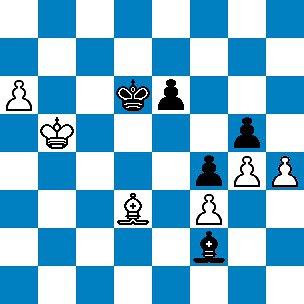Rohonyan, K (2354) - Schneider, D (2517) [A13]
Pan-American Championships (4), 29.12.2006
1.c4 e6 2.Nf3 d5 3.g3 Nf6 4.Bg2 dxc4 5.Qa4 c6 6.Qxc4 b5 7.Qc2 Bb7 8.O-O a6 9.d4 Nbd7 10.Rd1 c5 11.Bg5 Qb6 12.Nc3 Rc8 13.Qd2 c4 14.d5 Nxd5 15.e4 N5f6 16.Bxf6 Nxf6 17.e5 Nd5 18.Nxd5 Bxd5 19.Ng5 h6 20.Bxd5 hxg5 21.Be4 Qc7 22.Qxg5 g6 23.Qf6 Rg8 24.Qf3 Be7 25.Bb7 Rd8 26.Bxa6 Qxe5 27.Qc6 Kf8 28.Qxb5 Qxb5 29.Bxb5 Rb8 30.a4 Bf6 31.Rac1 Bxb2 32.Rxc4 Rb7 33.Rb1 Be5 34.Rc8 Kg7 35.Rxg8 Kxg8 36.a5 Bd4 37.Kf1 Rc7 38.Bd3 Rc3 39.Rd1 Bc5 40.a6 Ra3 41.Rd2 g5 42.Ke2 Kg7 43.Bc4 Rc3 44.Bd3 Ra3 45.Rc2 Bb6 46.h3 Kf6 47.Bc4 Kg7 48.Ra2 Rc3 49.Bd3 Ba7 50.Ra5 Kf6 51.Kd2 Rc5 52.Rxc5 Bxc5 53.f3 Ke5 54.Kc3 f5 55.Kc4 Bf2 56.Kb5 f4 57.g4 Kd6 58.Bf1?? Kc7 59.Bc4 Kb8 1/2-1/2
58.Bf1 was far too accommodating. White can play for a win with 58.h4!

This is the position that IM Dmitry Schneider, GM Magesh Panchanathan (second board for UTD-A), and I spent quite some time analyzing in D.C. The play after 58...gxh4 59.Bf1 is extremely complex. I can't recall what conclusion we reached, but the consensus was that black is struggling. My personal analysis (see below) seems to support this.
So, if you really want a challenge...try to find a way for black to hold this! It's best to analyze these sort of endings with a group or with the aid of a strong chess engine. Post your comments if you find something good.
All of my analysis is here. It should save you quite a bit of time! Beware though...it is possible that black is simply lost.
Good luck!

3 comments:
For the record 56...f4?? is a huge blunder. It's much better to move the king towards the queenside with Kd6 because then white pretty much has to make a passed pawn with h4. After that occurs, the black king comes back to the kingside. Since the black pawns are on e6 and f5- black can sacrifice the bishop for the a-pawn, win the h-pawn and then trade the remaining pawn with e5-e4 ideas.
Dmitri
I still cant draw the endgame -_-
Shredder 10 is not helping
John,
In the Rohonyan - Schneider game I think you have overlooked something.
1. h4 gxh4
2. Bf1 Be3 (This is one of your notes)
3. g5 Ke7
4. Kc6 Kf7
5. Kb7 Kg6
6. a7 Bxa7
7. Kxa7 Kxg5
8. Kb6 e5
9. Bh3 (Here you give +-, but I'm not convinced)
9. ... e4
10. fxe4 f3
11. e5 Kf4
12. e6 Kg3
13. Bf1 h3
14. e7 h2
15. e8/Q h1/Q
At this point, my Chess Engine (with endgame tablebases) is screaming that the position evaluates to 0.00.
What do you think?
Also, in some of the other variations, it seems to me that Black can put up
better resistance by leaving his pawn on e6 to prevent the White Bishop from going to f5 after the White g pawn has advanced. You may want to revisit some of those variations also.
Thanks,
Tom Ewers
Post a Comment